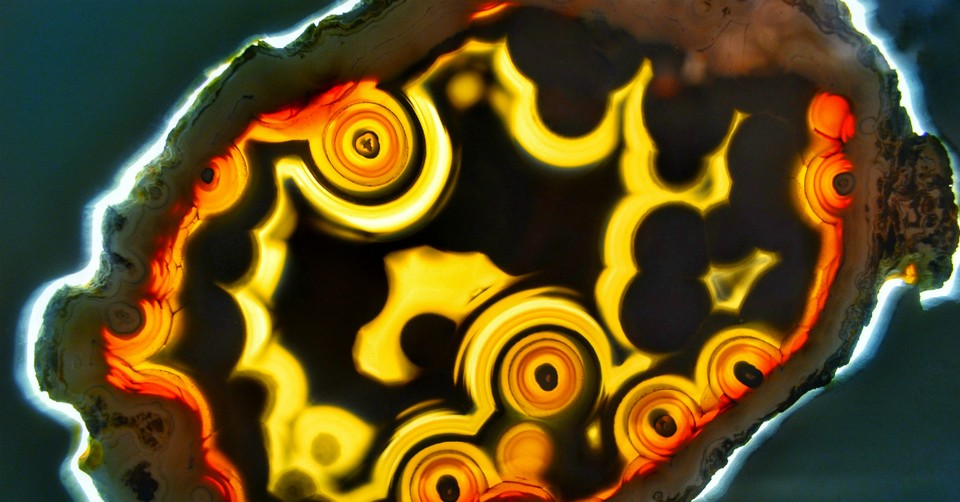Color Symbolism in the Apocalypse of John in Revelation

The Bible book of Revelations details the apostle John's prophecy of the Apocalypse and End Times. There are specific colors mentioned in John's vision that give meaning and symbolism to the events. Reading apocalyptic texts is more like strolling through an art gallery than walking step by step through a story. While most biblical narratives are more concerned with advancing the plot than describing the scenery, apocalyptic texts brood over every scene in exacting detail. For apocalyptic literature, the scenery is the plot.
And the apocalyptic writers aren’t interested in simply sketching a picture; their work is in full color. The book of Revelation is the most colorful book of Scripture, by far. Each hue in John’s palette has a built-in cultural association, which he uses to amplify the meaning of his visions.
RAINBOW/GOLD: Revelation is the only New Testament book to mention rainbows. Both times, the rainbow is an aura of pure glory emanating from a divine being—first God on His throne (4:3) and later a “mighty” angel (10:1). This angel is variously identified by commentators with God, Christ, “the Angel of the LORD” or one of the archangels.
BLACK: In his Gospel, John identifies Jesus as the cosmic light through which “all things were made” (John 1:3; compare Gen 1:3). Black is the absence of light, which for John means the opposite of God, since “God is light, and in him is no darkness at all” (1 John 1:5). Revelation 6:12 indicates that as part of the final judgment, the world will be plunged into darkness. The black horse in Revelation 6:5 represents the injustice of famine, and it may evoke burned crops as part of the final judgment (compare Deut 32:22–23; Lam 5:10).
RED: Red symbolizes war, destruction and above all, bloodshed. The Greek word for pure red, purros (πυρρός), is used twice in Revelation: to describe the second horse, which brings war, and the red dragon who opposes the Messiah (Rev 6:4; 12:3). Moreover, the moon and the sea are turned red “as blood” (Rev 6:12; 8:8). When Christ returns as a triumphant warrior, His robe is stained red with blood as He “treads the winepress” of His enemies (Rev 19:13–15; compare Isa 63:2–3).
SCARLET & PURPLE: Deep red cloth is found in the tabernacle and Solomon’s temple (Exod 25–30; 2 Chr 2:7, 14). Scarlet often signifies wealth and status, as scarlet dyes were expensive (1 Sam 1:24; Prov 31:21), but it also points to atonement: Scarlet yarn soaked in blood is used in ceremonial cleansing (Lev 14:4–6, 49–52; see Heb 9:19); Rahab and her family are saved under the signal of a scarlet cord (Josh 2:18–21); and Isaiah says that sin stains like dark red dyes that are nearly impossible to wash out (Isa 1:18). Purple was the most expensive dye in the ancient world, obtained at great cost and difficulty from marine mollusks. As such, it always represents wealth, power and status. When we see the great prostitute in Revelation 17 clad in purple and scarlet, we are meant to be appalled at her scandalous sins and her obscene wealth (compare Jer 4:30).
GREEN: When applied to plants and vegetation, the Greek word chloros (χλωρός), meaning “yellowish-green,” indicates freshness and life (Rev 8:7; 9:4). When the same color is used for the “pale” horse in Revelation 6:8, whose rider is Death, it indicates plague, disease and death. Pale green vegetation is healthy and delicious; pale green meat is not.
WHITE: The most frequently mentioned color in Revelation is white, which always symbolizes spiritual purity. In particular, white garments symbolize the personal holiness of the wearer (Rev 3:4–5; 4:4; 7:9; 19:14). The garments of Christ and other divine beings are naturally white (see Dan 7:9; Matt 17:2; 28:3; Mark 9:3, 29; 16:5; Acts 1:10), but the garments of saints and martyrs are made white (ironically) by bleaching away scarlet sins in the red blood of the lamb (Rev 7:13–14; compare Isa 1:18).
JEWEL TONES: Both God’s throne and the new Jerusalem are bedazzled with gems and metals of every hue and brilliance (Rev 4; 21:9–27).
This explosion of jewelry is not meant to portray the unimaginable wealth of God, but rather His indescribable glory: There is no wealth when the whole world is yours and everything in it (Deut 10:14). In the Old Testament, brilliant gems are seen when the elders of Israel dine with God on His mountain (Exod 28:20) and when Ezekiel sees the chariot and throne of God (Ezek 1:16; 10:9). The angel who reveals visions to Daniel and the “guardian cherub” that Ezekiel describes being cast out of heaven are similarly encrusted with jewels (Dan 10:6; Ezek 28:13). These precious and semiprecious stones were the most brilliantly colorful substances known to the ancient world.
The book of Revelation is, above all, a vision. As such, it ranks the Apostle John among the greatest visual artists of all time, even though his palette is filled with words—not paints. Each intricate detail of every scene and portrait he draws transcends mere decoration: It is a symbol, pregnant with meaning.
EDITOR'S NOTE: This previously-written article has become a resource for many seeking to understand if the Coronavirus pandemic is an End Times plague. We hope it can direct you toward scriptural truths about plagues and a study of the Book of Revelation. In addition, the following articles may offer more encouragement for all to remember as we face the trials of COVID-19 together:
- Prayers for Peace Amidst Pandemic Fear
- What Does the Bible Say About Coronavirus: Is it a Sign of the End Times?
- Did God Send the Coronavirus as a Biblical Plague from Revelation?
- What Is the Mark of the Beast in the Bible?
- Who Are the Four Horsemen in Revelation? Their Meaning and Significance During Apocalypse
Get more out of your study of apocalyptic literature with The Apocalypse of John. Order it today at Logos.com/Beckwith
©Unsplash/Viktor Forgacs
Article courtesy of Bible Study Magazine, a product of Faithlife Corporation, makers of Logos Bible Software. Each issue of Bible Study Magazine provides tools and methods for Bible study, as well as insights from Bible teachers, professors, historians, and archaeologists. Learn more at https://biblestudymagazine.com. Originally published in print: Copyright Bible Study Magazine (Jul–Aug 2012): pgs. 30–31.
Originally published March 18, 2020.







